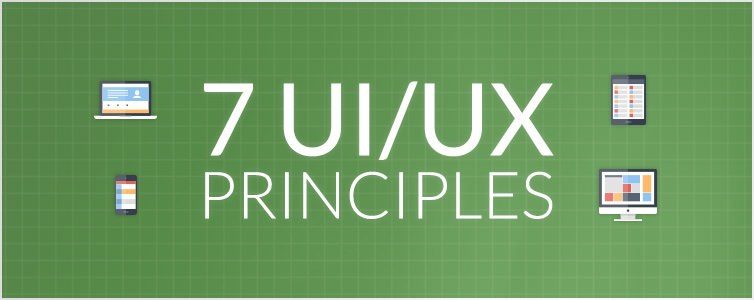Article
7 UX/UI design principles to help create an engaging experience

Most of us spend 3+ hours online every day using a myriad of devices with screens that require near exclusive attention where over 1 trillion web pages and millions of mobile apps are competing for our time. To help you be effective, Fresh Consulting has selected 7 of our 50+ principles that assure your application or website is sweet and stands out from the rest.
1. Design should focus on an experience
People don’t always remember information presented, but they do remember what they feel. Advertisers focus on selling to our hearts, so why shouldn’t you? As Geoffrey James in an Inc.com article states, “[It] is not the information itself that is important, but the emotional effect that the information has on your audience.”
This is why User Experience Design, or UX design, has become such an integral part of web and application work. It should effectively weave together a combination of text, graphics, layout, and interactive elements to ensure users have an experience, not just an informational view.
With all of the complexity and quantity of information we are swimming in, differentiation matters. If you scan through today’s interfaces, they incorporate more visuals, more story, and more emotion to help convey why they matter in the sea of competitors. This brings us to our next point…
2. People scan websites, they don’t read them
Make your website scannable because users don’t read websites the way they read other material. Is it any wonder why the use of infographics has become standard fare for anyone looking to convey sets of data or instructions? Research shows that “users switch from scanning to actually reading the copy when web content helps [them] focus on sections of interest.”
Case in point, you probably are not going to read this entire article, rather scan the headlines and dive in where you want to read further. Making your interface scannable will make it simpler for today’s audiences, which brings us to our next point…
3. Users crave simplicity and clarity
It takes as little as 0.5 seconds for visitors to decide whether they are interested in a website or not, so be clear with what you want users to do. Today’s interfaces need “preferred actions” to be as obvious as possible. Users should not have to think about what you want them to do. For example, it could mean focusing visual attention on one button vs. four on your home page.
Consider what your web app or website can do to make it easy to use. For example, a form can give default values most users would adhere to rather than giving every option available. Part of design is designing for the majority of your users and letting extra functionality be discovered as needed (e.g. through hover controls) without delivering everything in your face.
A consistent design is actually simpler for users because it reuses components, behaviors, colors, and aesthetic to reduce the need for users to rethink. Users are already familiar with many of the components used throughout the web so complying with these patterns will make the system simpler and clearer to begin with, which brings us to our next point…
4. Know where to get creative and where to use common design patterns
Be careful with innovating new UI patterns that are already commonly known patterns elsewhere. You don’t want people to have to think too hard about where common elements are. Most interfaces should already be familiar to users. For example, links should look like links. Buttons should look like buttons. Login access is typically located in the upper right; logos and company names upper left.
Getting too creative with common patterns is like saying, “Let me put the blinker for the car with the radio controls,” rather than using the standard up/down stick on the left of the steering wheel. It might feel cool to do something non-traditional, but cool does not mean usable. Usability and creativity need to be balanced.
Navigation, URLs, and button placement should focus on usability first before design aesthetic. This is why its best practice to wireframe without design aesthetic to begin with to focus on layout first. Then you can focus on getting creative so the creativity is appreciated, which brings us to our next point…
5. Design to capture someone’s attention above the fold rather than design everything above the fold.
First, designing for “above the fold” needs to be put in context. The fold varies for every device–a fold for a laptop could be three times as small as a fold for a large desktop and a mobile device might have a fold twice as small as a laptop.
This means that while the “above the fold” content is important, it is more important to capture user attention into your experience than it is to put everything above. Putting everything above the fold would be, as Eric Huber states, “the equivalent of taking everything in your store and putting it on the curb, along with painting every sales price on the doors and windows, just in case someone passing by might not come in your store.”
Of course, the stuff above the fold is still important in your information hierarchy because its the first thing people see; however, when you balance the importance of simplicity, clarity, and experience, it puts the ever-changing fold line in context as one variable of many.
It is simply a dated notion that everything important has to be above the fold. What is not dated is capturing someone’s attention so that they want to and do scroll down and experience the rest of your website or application, which bring us to our next point…
6. Scrolling is often faster than paging
Today’s websites are vertically longer, much longer than sites of old when designers thought everything needed to be above the fold. Take this example from Amazon that sells their new Kindle, if you print this page out, it is 17 pages long. While Amazon is unique and their practices as the world’s leading ecommerce site are not best practice for everyone, just visit 10 modern company websites and you’ll probably find the average printed page length to be 3 – 6+ pages.
Back in 1997, Jakob Nielsen, a long time web usability expert, retracted the guideline to avoid scrolling web pages in order to let users focus on speed. He went on to say “scrolling beats paging” because it’s faster to scroll down than to click, which means longer pages can be better than just more pages. Today’s web navigation is flatter as a result.
We often say “clicks are expensive in usability” but what we really mean is that clicks that require page refreshes are “expensive.” People just don’t click as much we design for. At the end of the day, most of us are looking for the easiest and fastest route to get what we need. Scrolling more vs. clicking again may help with that.
The fact is, we’re very fast at scanning a website (see #2) but the average website refresh is 6.5 seconds. What would you rather do? Click into 4 places that takes 27 seconds or quickly scan a longer home page in 5-10 seconds? Flicking and panning on our mobile and tablet devices has only strengthened our scrolling frequency, which brings us to our next point…
7. Build nice responsive design vs. just responsive design
Responsive design–designing your website or app to have a fluid interface for varying device sizes–has been popular for the last few years. If you’re not on the responsive design bandwagon yet, you’ve probably heard that it’s important, but does it really make a difference? Research continues to prove that it does.
However, most design companies, including ourselves originally, were designing websites to be responsive just to be responsive but the size of images and text were sometimes skiwampus in proportion. Users are on all device types of all screen sizes, so you naturally want your site or app to look good everywhere. And there is difference between having responsive design and a responsive design that looks good. So after you’ve checked the box, look at your responsive design on a mobile or tablet device and ask yourself if it is nice.









